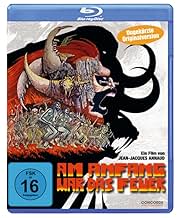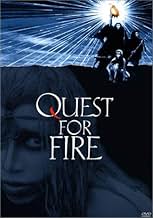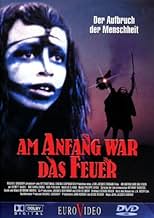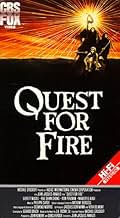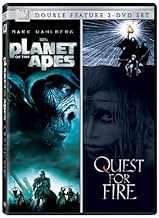This story takes place in prehistoric time when three tribesmen search for a new fire source.This story takes place in prehistoric time when three tribesmen search for a new fire source.This story takes place in prehistoric time when three tribesmen search for a new fire source.
- Won 1 Oscar
- 11 wins & 8 nominations total
Nicholas Kadi
- Gaw
- (as Nameer El-Kadi)
Franck-Olivier Bonnet
- Aghoo - The Ulam Tribe
- (as Frank Olivier Bonnet)
Joy Boushel
- The Ulam Tribe
- (as Joy Boushell)
- Director
- Writers
- All cast & crew
- Production, box office & more at IMDbPro
Storyline
Did you know
- TriviaBoth Ron Perlman and Everett McGill suffered frostbite; luckily they were able to heal completely. Despite the working conditions, they both enjoyed making the film.
- GoofsThere were no saber-toothed cats in Europe at any time. Saber-Toothed cats evolved in North America, then spread to South America during the Great American Interchange (when the Isthmus of Panama rose from the sea and connected North and South America). There *were* very large cave lions (Panthera Spelea) in Europe, but they had the regular dentition of modern African lions (Panthera Leo).
- Quotes
[first lines]
Title Card: 80,000 years ago, man's survival in a vast uncharted land depended on the possession of fire. / For those early humans, fire was an object of great mystery, since no one had mastered its creation. Fire had to be stolen from nature, it had to be kept alive - sheltered from wind and rain, guarded from rival tribes. / Fire was a symbol of power and a means of survival. The tribe who possessed fire, possessed life.
- Alternate versionsAll UK versions are cut by 8 secs and are missing a shot of a wolf on fire.
- ConnectionsFeatured in À propos de 'La guerre du feu' (1981)
Featured review
Raw and at times brutal, this story follows three primitive warriors who make a cross-country journey in search of that most precious of natural elements ... fire. In prehistoric times, having fire meant survival from the cold and protection from predators.
In this film, facial gestures, hand movements, general body language and mannerisms of the characters are all consistent with conclusions about early man, as a result of thorough anthropological research. In lieu of modern language the film's dialogue consists of some 350 invented words and sounds, also based on research. In addition, an important part of the film is attention to detail in costumes and makeup, for which the film won several awards. All of these technical cinematic elements combine to create a reasonably accurate visual and audio impression of mankind as it existed some 80,000 years ago.
As you would expect, the film is shot entirely in rugged, remote locations, resulting in landscapes that are stunningly beautiful. Background music is generally low-key and ethereal, like what you might hear in a sci-fi film. There's lots of flute sounds, which reinforce the simplicity of the time period.
For all its technical achievements, this film's main weakness may be the screenplay. When you take away the artifacts of modern life, you're very limited in the kind of story you can tell. And that clearly is the case here, with a plot that drones on with a monotony and repetition that can be tedious, and at times difficult for some viewers.
Although the story's entertainment value may be marginal, "Quest For Fire", with its low tech cinematic style, is interesting not only for its technical elements but also for its over arching theme of modern human's continuity with prehistoric man, based on the element of fire.
In this film, facial gestures, hand movements, general body language and mannerisms of the characters are all consistent with conclusions about early man, as a result of thorough anthropological research. In lieu of modern language the film's dialogue consists of some 350 invented words and sounds, also based on research. In addition, an important part of the film is attention to detail in costumes and makeup, for which the film won several awards. All of these technical cinematic elements combine to create a reasonably accurate visual and audio impression of mankind as it existed some 80,000 years ago.
As you would expect, the film is shot entirely in rugged, remote locations, resulting in landscapes that are stunningly beautiful. Background music is generally low-key and ethereal, like what you might hear in a sci-fi film. There's lots of flute sounds, which reinforce the simplicity of the time period.
For all its technical achievements, this film's main weakness may be the screenplay. When you take away the artifacts of modern life, you're very limited in the kind of story you can tell. And that clearly is the case here, with a plot that drones on with a monotony and repetition that can be tedious, and at times difficult for some viewers.
Although the story's entertainment value may be marginal, "Quest For Fire", with its low tech cinematic style, is interesting not only for its technical elements but also for its over arching theme of modern human's continuity with prehistoric man, based on the element of fire.
- Lechuguilla
- Jan 29, 2007
- Permalink
- How long is Quest for Fire?Powered by Alexa
Details
- Release date
- Countries of origin
- Languages
- Also known as
- The War of Fire
- Filming locations
- Production companies
- See more company credits at IMDbPro
Box office
- Budget
- $12,500,000 (estimated)
- Gross US & Canada
- $20,959,585
- Gross worldwide
- $20,962,615
- Runtime1 hour 40 minutes
- Color
- Aspect ratio
- 2.35 : 1
Contribute to this page
Suggest an edit or add missing content



![Bande-annonce [OV]](https://m.media-amazon.com/images/M/MV5BZTg3YWU0MTMtMDk1Mi00M2Y4LWFiODgtYzFhOTAyMWRjYWY2XkEyXkFqcGdeQXRyYW5zY29kZS13b3JrZmxvdw@@._V1_QL75_UY281_CR74)
